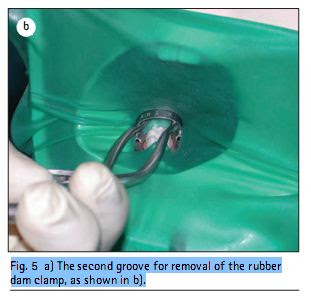A well-trained dental nurse and a well organised surgery, are essential for efficient application of the rubber dam. If a tray is prepared with ready punched sheets, and sterilised clamps already flossed, application can be performed in a matter of seconds.
There are three standard methods of application, described and illustrated here.
Winged technique
The appropriate winged clamp (8A for molars, 1 for premolars) is selected and flossed. The rubber dam is punched and aligned with the quadrant to be treated. The clamp is held in the forceps and retained with the ratchet. The hole in the rubber is stretched across the wings of the clamp, positioning the bow of the clamp towards the back of the arch. All this may be done by the dental nurse while the dentist is otherwise occupied,






